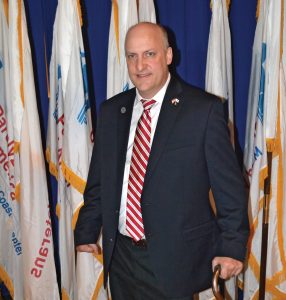If your PVA history knowledge is a little cloudy, you’re not alone
By David Zurfluh
After attending a February webinar with Wheels of Courage author David Davis, I realized my knowledge of PVA history is lacking. Davis’ book tells the story of Paralyzed Veterans of America (PVA) members from World War II who helped transform the world’s image of paralyzed veterans through wheelchair basketball.
PVA Publications Editor Tom Fjerstad has a vast knowledge of PVA history, and he recently motivated me to learn more about it. When he comes across information on PVA during his historical mining ventures, Fjerstad shares it with me and expands my knowledge a little each time. Davis’ book was the push I needed to commit more time to learning PVA’s history.
I think, as time goes by, people take for granted why they have the things they do and what it took to get them. As I wrote this column, I thought of these pertinent questions for you to chew on and discover answers to:
- Where and when did PVA start?
- Who was PVA’s first national president?
- Which doctor is considered the founder of spinal-cord injury and disease medicine?
- Where was the first PVA chapter?
- Where is the newest PVA chapter?
- What was the highest number of chapters?
- What was the fewest number of chapters?
- Who was the first female national executive committee member?
- Who was the first female PVA member?
- Where did PN first start?
- Where was PVA’s first national office?
- Where and when were the first National Veterans Wheelchair Games?
- Where and when was PVA’s first convention?
To the chapters out there, think of making an effort to document and form a chapter history committee to acknowledge your past for future generations.
Additionally, there are two PVA members right now who make members’ lives better through mobility products — Peter Axelson, MSME, ATP, RET, and Rory Cooper, PhD.
These men have improved and continue to improve PVA and the disabled community’s world through mobility product design, policy and mobility product engineering education. Someday, a book will be written on their life’s work and contributions to PVA members and the disability community.
I heard someone say once that in order to move into the future, you must first learn and understand the past. In today’s “cancel culture,” there are those who want to do the opposite or revise history. What our past leaders did got us to the present and gave us the ability to write our future.
It’s up to us to give the next generation the ability to write their future. Past PN magazines and PVA chapter newsletters are your most detailed source to learn PVA’s history in detail. There are also three books and one movie listed below that will provide insight.
Books
Beyond Dancing: A Veteran’s Struggle — A Woman’s Triumph by Anita Bloom Ornoff (2003 & 2016)
Quadalajara: The Utopia That Once Was by Jack Tumidajski (2005)
Wheels of Courage by David Davis (2020)
Movie
The Men (1950)
If you choose to delve into PVA history, I hope you discover these three takeaways:
1) You expanded your knowledge of PVA history and those who came before you.
2) You gained an appreciation for what it took to improve our lives.
3) You’ll use the PVA history you learned as motivation to continue the tradition of paying it forward for others.
My challenge to you is to learn five new things about PVA’s history. Become an advocate this April and spread PVA awareness!



